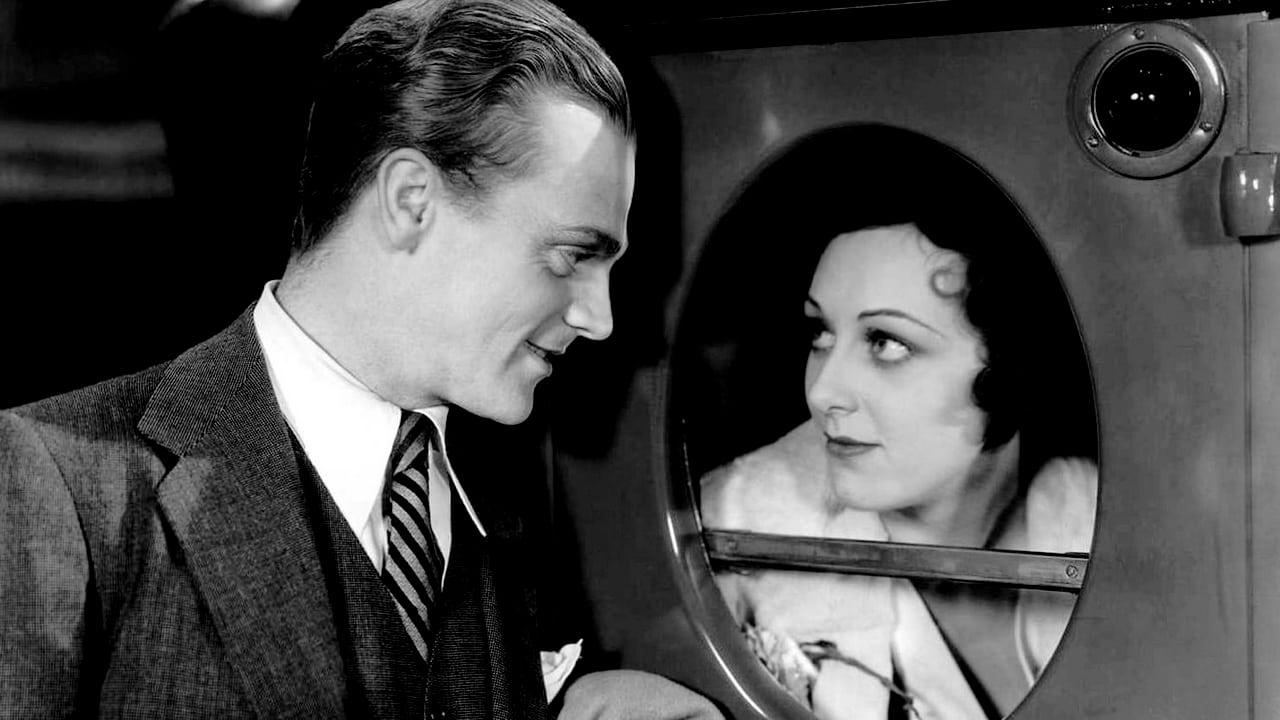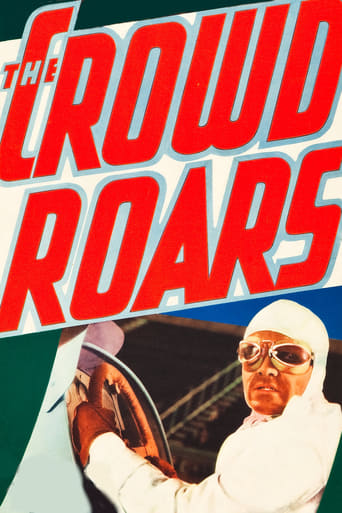

"The Crowd Roars" wouldn't be half as good if it wasn't for James Cagney. He had that knack for being able to carry a film if the plot was a bit ordinary or if the script wasn't up to much. The latter certainly applies to this film as the dialogue is pretty standard. However, Cagney in his energy and his delivery, adds a real zest to the story about a professional racing driver who becomes a bit too protective of his younger brother after he has ambitions to become a driver. When tragedy strikes, Cagney becomes a bit of a drifter who loses his sense of self-worth and his nerve regarding his career. Although Joan Blondell is billed second after James Cagney, she isn't really his leading lady. Their scenes are written so that they are opposites to each other as there is some tension between them. The scenes with the car races are very good and are exciting. Another winner for Cagney!
... View More. . . Ann Dvorak says to James Cagney after five minutes of THE CROWD ROARS. Warner Bros. feels that Ann's observation is so important that they have Cagney repeat it to his kid brother five minutes later for the benefit of theater late-comers. Was Warner cautioning ONLY contemporary audiences about "race" cars Snailing along at Today's Go-Kart pace with this line of dialog? Obviously not, since little if any effort is made toward Realism with THE CROWD ROARS' production. Depicting "Indy Cars" tooling around on a dirt half-mile horse track in blinding clouds of dust as their tires fray faster than Firestones in a desert surely was intended then (and now) to be taken as a metaphorical allegory by Warner Bros.' always prophetic Early Warning Providers. A few years following the release of THE CROWD ROARS, Warner's future Farm Team--MGM--rehashed the Racist Confederate Red Staters' perennial fascination with and hankering for Bloody Wrecks during the opening party scene of GONE WITH THE WIND. Because Southern Bigotry could not long survive without a Fellow Traveler, Warner itself dropped the other boot stomping America to death around the same time as MGM's yawner (the snooze-fest GWTW).Warner's CONFESSIONS OF A NAZI SPY shows large subsets of the USA's Urban Population as they fall under the sway of Rich People Party Fascism. In THE CROWD ROARS, Cagney half-strangles his sister-in-law Joan Blondell and literally burns his employee "Spud" to death in front of Spud's family. The latter incident causes Cagney to complain about Air Pollution (anticipating the Real Life on-site Nazi Death Camp wive's lament a decade later), but Cagney doesn't give a thought to Spud's widow and child. This, of course, foreshadows the Deplorable Misogyny and Miserly Callousness later epitomized by America's Fascist President #45. THE CROWD ROARS' Irish-on-Irish violence takes GWTW's Racism to its ultimate extreme, as subtle clan and class distinctions cause Cagney to reject Blondell as being "beneath" his kid brother. Warner's implication is that only some sort of Incestual In-Breeding can satisfy these insular insecurities demanding a "Purer" Breed. Warner further warns us of the dangers of putting Trainwrecks on any ballot in America: The Confederate Nazis will rig the election for the Choo Choo Crash every time!
... View MoreThe title means that the crowd is expecting something exceptional will happen:they want blood .When in Rome,do as Romans do.Weren't it for the final scenes the screenplay would look like "a star is born" in the race cars .Two brothers ,one of them (Cagney) is a famous champion when his kid brother wants to follow suit.In spite of Big Brother's good piece of advice (see above),he carries on regardless of the warnings.They have women for them,the elder has Ann Dvorak whereas the kid brother falls for her friend (Joan Blondell).The old champion is not prepared to accept it either.The car races are well filmed for the time and make up for the paucity of the plot,which is entertaining though.
... View MoreThis race-car drama, directed by Howard Hawks, was a personal project of his: Hawks had a lifelong passion for stock-car racing, and he persuaded several top racers to appear in this film as themselves (although demonstrating very little screen presence). I was expecting 'The Crowd Roars' to be quintessential Hawks: a two-fisted he-man drama, with the girly stuff kept to a minimum. In the event, I was surprised at how much 'chick-flick' material is in here, and pleasantly surprised at how well it works. A substantial amount of this movie is emotional drama between the four leads, in the implausibly spacious apartments occupied by the characters played by Ann Dvorak and Joan Blondell.James Cagney stars as Joe Greer, a stock-car driver at the top of the game: he's just won the Indy 500, and his hero-worshipping kid brother Eddie is eager to follow in his skid marks. Eddie is played by obscure actor Eric Linden, whose Noo Yawk accent blends well with Cagney's, but who otherwise failed to convince me that they were brothers. Annoyingly, Cagney attempts to dissuade Linden with that cliché "It's not for you" dialogue that I've heard in a dozen other movies: the one where the guy who's hugely successful in his profession attempts to convince someone else to stay out of that same profession. Guy Kibbee, in a tiny role as the Greer brothers' father, is excellent and absolutely convincing as the proud dad.Cagney has a poorly-defined romance with Dvorak, who spends all of her screen time in monotone mode ... except for one emotional monologue in which she turns on the waterworks and is surprisingly effective. Dvorak's friend is played by Joan Blondell, so I expected this role to be played in Blondell's usual 'weary dearie' mode. Again, I was pleasantly surprised. Elsewhere, I've mentioned that I always find Blondell coarse and common on screen. Here, she's amazingly good: she wears a tasteful outfit that shows off a couple of shapely gams. (When did they turn into hams?) This is the only movie in which I've seen Blondell play a realistic human being instead of a bundle of clichés. But we still get some of the standard Warners thick-ear dialogue: 'Ya can't grow wings on that guy.'The racing scenes, necessarily, involve editing these actors into authentic stock-racing footage, so there's unavoidably some very bad shot matching. What's less pardonable (because it was more avoidable) is some very bad audio matching on the soundtrack. We *see* thousands of people in the stands, all reacting as a race car bursts into flames ... but we *hear* what sounds like maybe six women squealing. Almost as if to make up for this lapse, during the chick-flick scenes there is some very scrupulous shot matching. I was especially impressed by a two-camera set-up in a dialogue scene between Dvorak and Frank McHugh. He holds a lighted cigarette in his hand throughout the scene, and the smoke in Dvorak's set-up matches the smoke in McHugh's set-up. Also, McHugh's cigarette is burnt down to the same length in both set-ups. Most movies aren't this careful!Obscure actress Charlotte Merriam, as McHugh's wife, has one powerful scene in which she rushes onto the track during an auto race, like a suffragette at the Grand National. (The undercranking here is obvious.) It's a shame that this scene did nothing for Merriam's career. Character actor Edward McWade has one excellent sequence.This movie is more confusing than it needs to be. There are two different characters cried Red, and two named Spud. Cagney and Linden spend most of the movie as rivals, but there's a last-minute reconciliation that seems to have been left on the cutting-room floor: it certainly isn't in the movie.SPOILERS COMING. The last scene in the movie finds Cagney and Linden in an ambulance, bound for hospital, with two rival drivers bound for the same hospital in another ambulance. With one of those would-be 'cute' Hollywood touches, the two sets of passengers urge the ambulance drivers to race each other through the streets. I really despise the cult of speed for the sake of speed: every year, a few innocent people get killed because of idiots who think that a public highway is their personal dragstrip. Race-car driving doesn't work very well as a vehicle for macho movie heroes, since it relies so heavily on stunt doubles, stock footage and (in this case, very badly done) rear projection. The romantic scenes in 'The Crowd Roars' actually work better than the macho gearshift stuff, and I'll rate this movie just 5 out of 10.
... View More